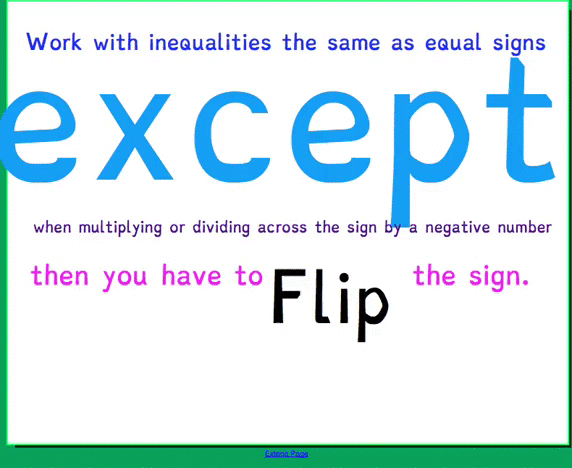There are many things that I do that I was surprised to find the the UDL Guidelines (2011). Checkpoint 8.1 says to restate the initial goal. I do that all the time. When teaching how to solve inequalities, students always forget that sometimes you have to flip the sign. I put this slide in my lesson about 4 times the first day, and came back to it multiple times in following lessons.

It did help them get the point.
This past year in my class, I had two hard-of-hearing students. The way I have created slide has changed over time to help those students, and it something that could be taken right out of UDL. I have also been getting big classes in my geometry classes. Usually they are above 40, which means that some desks are right up against the back wall. I was noticing that I couldn't really see the SmartBoard from the back of the class so the students probably are having a hard time, too.
1st year teaching geometry

2nd year teaching geometry

3rd year teaching geometry

The first year, it is hard to read, the picture isn't labeled, and the text is tiny. The second year, I was deriving the formula for them, but I never gave them the final presentation of it as a complete theorem. My third year, I seem to have my act together. The text of the formula is big. I color-coded the points to help them follow how the x's and y's travel. And I wrote out the formula in text, which is a huge help for them. I did the same thing this year for my Algebra class with the quadratic formula, and some of the student that couldn't write it in symbols could still recite it for me. This shows me that Checkpoint 2.1 is important because I am showing the formula in different representations. To add to it, I think I would put I diagram of the triangle that was color-coded to the formula.
I have also been using a typeface designed to be easier to read for people with dyslexia, called dyslexie, from studiostudio. I believe it helps everyone read better. I even have it installed on my Kindle and I can read much faster with it.
Example of the dyslexie font

The lesson I am revisiting is the introductory lesson on hypothesis testing for my Statistics class. This lesson took place over 3 days (1 collab period [44 minutes], and 2 block periods [105 minutes]).
This is my UDL Guideline Worksheet for this lesson.
As I was working through the UDL Guideline and putting my notes it, I thought it would be best for me to rate myself with a number and how well I thought I was already doing each element. I made a new column and rated between 1 (didn't do it) to 4 (fabulous). More data is good. Here is my data:
Rating | Frequency –––––––+––––––––––– 4 | 2 3 | 10 2 | 8 1 | 11
That makes my UDL GPA 2.1. Not very good. The best two ratings were on "Checkpoint 2.2 - Clarify syntax and structure" and "Checkpoint 6.3 - Facilitate managing information and resources." There are two whole groups that I rated myself as a one: "Guideline 9: Provide options for self-regulation" and "Guideline 4: Provide options for physical action."
There are two things I would like to improve. The first relates to flipping the classroom. I would make a video going over the main vocabulary from the text instead of having them just read it. I could also use the video to connect to the previous chapter's concept of confidence intervals and how that relates to α. I would also add closed captioning to this video. We have the school districts Deaf and Hard-of-Hearing program at my school, and they will do closed captioning for youtube videos if you ask them nicely enough. The Means, Toyama, Murphy, Bakia, and Jones (2010) study found that online learning and blended learning produces stronger learning experiences, with blended classrooms having the strongest learning experiences. Flipping the classroom is the first step, for me, to start the online part of my class.
The second thing I wanted to revisit was the worksheet. 8.1b Hypothesis testing unfair coins UDL is my revised worksheet. This is the original 8.1b Worksheet for comparison. I restated the 5 steps for hypothesis testing to emphasize the goal for this lesson again. I rearranged the process to follow exactly how hypothesis testing is done in the rest of the chapter. The "Step #" is clearly laid at the beginning of each step. I put boxes around the parts of the worksheet that are what they will be expected to write when they do tests by themselves. I also put cues in a handwriting font to give them hints about what is expected for that box. On a digital version, I might put a hyperlink or tooltip. In step 5, I used a sentence stem to help prompt them about the structure of what they are supposed to write.
I think the UDL guidelines are very helpful in making great lessons. They offer great starting points about places to think about my teaching and my lesson design. Just as we learn with the Third Teacher+, designing the physical environment our students learned in, the design of the learning experience is important, too. If we do not make lesson accessable to everyone, then they cannot even begin the experience.
CAST (2011). Universal Design for Learning Guidelines version 2.0. Wakefield, MA: Author. Retreived from http://www.udlcenter.org/sites/udlcenter.org/files/UDL_Guidelines_Version_2.0_(Final)_3.doc
Means, B., Toyama, Y., Murphy, R., Bakia, M., & Jones, K. (2010). Evaluation of Evidence-Based Practices in Online Learning: A Meta-Analysis and Review of Online Learning Studies. US Department of Education, Office of Planning, Evaluation, and Policy Development, Washington, D.C. Retrieved from http://www2.ed.gov/rschstat/eval/tech/evidence-based-practices/finalreport.pdf

No comments :
Post a Comment